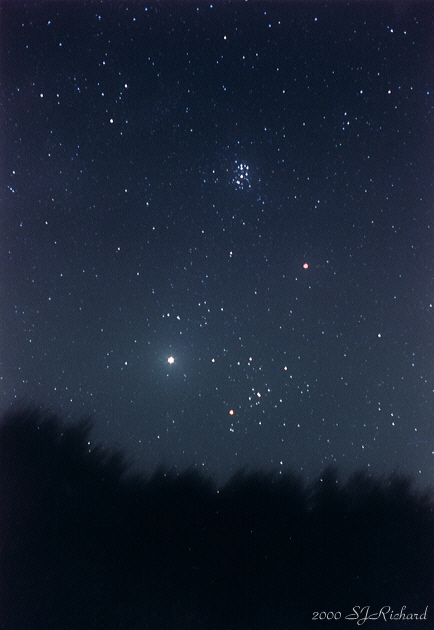
|
Credit & Copyright: Stan Richard
Explanation:
Star clusters, planets, and a red giant posed
for this portrait of the
night sky from rural
Jasper County, Iowa, USA.
Astrophotographer
Stan Richard recorded the four minute
time exposure looking east around midnight on September 3rd at
Ashton-Wildwood Park.
To avoid
star
trails, his camera was mounted on a
barndoor-style
tracker to compensate for the Earth's
rotation.
Can you identify his celestial subjects?
(Click on the image for a labeled version.)
The Pleiades and
Hyades,
the closest open or galactic
star clusters
to the Sun, should be recognizable to beginning
stargazers.
Of course gas giant
Jupiter
rules as the brightest object in the picture
and the largest planet in the Solar System,
but second largest planet
Saturn is
also visible nearby.
For sheer size cool
red
giant star Aldebaran is more impressive though,
spanning about forty times the diameter of the Sun.
Sixty light-years away and yellowish in this picture,
Aldebaran is known as Alpha Tauri, the brightest star
in Taurus, the Bull.
|
January February March April May June July August September October November December |
| ||||||||||||||||||||||||||||||||||||||||||||||||
NASA Web Site Statements, Warnings, and Disclaimers
NASA Official: Jay Norris. Specific rights apply.
A service of: LHEA at NASA / GSFC
& Michigan Tech. U.
Based on Astronomy Picture
Of the Day
Publications with keywords: Jupiter - Saturn - pleiades - aldebaran - hyades - sky
Publications with words: Jupiter - Saturn - pleiades - aldebaran - hyades - sky
See also:
- APOD: 2025 November 16 Á Crossing Saturns Ring Plane
- APOD: 2025 September 25 Á Saturn Opposite the Sun
- APOD: 2025 September 22 Á Equinox at Saturn
- APOD: 2025 August 25 Á The Meteor and the Star Cluster
- APOD: 2025 July 8 Á The Pleiades in Red and Blue
- APOD: 2025 May 25 Á Beneath Jupiter
- Painting with Jupiter
